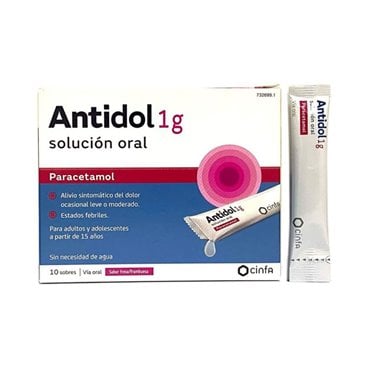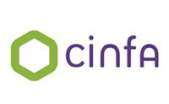Antidol 1 G 10 Sachets Effervescent Powder
This medicine is used for the symptomatic relief of occasional mild or moderate pain, such as headaches, dental pain, muscle pain (contractures) or back pain (lumbago), as well as febrile states in adults and adolescents from 16 years of age (or weight body weight greater than 50 kg).
This medicine is used for the symptomatic relief of occasional mild or moderate pain, such as headaches, dental pain, muscle pain (contractures) or back pain (lumbago), as well as febrile states in adults and adolescents from 16 years of age (or weight body weight greater than 50 kg).
Antidol (1 G 10 Sachets Effervescent Powder)
ACTION AND MECHANISM
Paracetamol is a derivative of para-aminophenol with analgesic and antipyretic activity.
Analgesic effect: Its mechanism of action is not completely clarified, but it seems to be fundamentally mediated by the inhibition of cyclooxygenase at a central level, especially COX-2, decreasing the synthesis of prostaglandins. It also has a certain peripheral effect by blocking the generation of the painful nerve impulse. A possible peripheral effect is also proposed due to inhibition of prostaglandin synthesis, activation of the CB1 cannabinoid receptor, modulation of serotonergic or opiate signaling pathways, inhibition of nitric oxide synthesis or hyperalgesia induced by substance P.
Antipyretic effect: Acts on the hypothalamic thermoregulatory center, inhibiting the synthesis of prostaglandins and the effects of endogenous pyrogen, leading to peripheral vasodilation, increased blood flow to the skin and increased sweating, which contribute to heat loss.
At the same dose, it has an analgesic and antipyretic power similar to acetylsalicylic acid (ASA). The effects are maximum after 1-3 hours and last for 3-4 hours. Unlike ASA and other NSAIDs, it does not have appreciable anti-inflammatory activity, except in some non-rheumatic pathologies. An advantage over NSAIDs is that it does not inhibit the synthesis of prostaglandins at the gastric level and appears to increase it, so it does not give rise to gastro-injurious effects. It also lacks antiplatelet effects.
PHARMACOKINETICS
Absorption: Rapid and complete after oral administration, with a bioavailability of 75-85%. After a dose of 1000 mg, a maximum concentration of 7.7-17.6 mcg/ml is obtained after 0.5-2 hours. It presents an important saturable first pass effect from doses of 2 g.
- Effect of food: Food can reduce the rate of absorption of paracetamol, but does not substantially modify the amount absorbed.
Distribution: It is widely distributed throughout most tissues, reaching concentrations similar to plasma concentrations. Its volume of distribution is approximately 1 l/kg. It accumulates especially in the liver and renal medulla. Distribution is moderately rapid, with a plasma half-life of 1-3 hours, and may be faster in adolescents. It has low binding to plasma proteins, around 10%, and may be 20-40% in acute overdose. It is capable of crossing the placenta and the blood-brain barrier.
Metabolism: It undergoes intense hepatic metabolism (90-95%) through conjugation reactions, mainly with glucuronic acid and sulfate. The metabolization routes are saturable at high doses, especially sulfation, which causes it to be metabolized by alternative routes by cytochrome P450 (CYP2E1), generating hepatotoxic metabolites such as N-acetyl-P-benzoquinone imine (NAPBI).
Elimination: It is excreted mainly in the urine in the form of glucuroconjugated metabolites (60-70%) and, to a lesser extent, conjugated with sulfate (20-30%) and cysteine (3%). Its elimination half-life is 1.5-3 hours. It is partially removed by hemodialysis, hemoperfusion and peritoneal dialysis.
- Special situations:
- Children: Neonates may have a slightly longer half-life (4-11 hours), while in older children it is similar to that of adults (1.5-4.2 hours).
- Elderly: They may have a somewhat longer half-life.
- Renal failure: Elimination may be decreased in patients with end-stage renal failure (ClCr < 10 ml/min).
- Liver failure: They may have a slightly longer half-life.
- Special situations:
INDICATIONS
Antidol 1 g oral solution is indicated in adults and adolescents over 15 years of age and weighing over 50 kg for the symptomatic treatment of pain of mild to moderate intensity, such as:
- Headache
- Dentistry
- Dysmenorrhea
- Osteomuscular pain (muscle contracture, torticollis, low back pain, osteoarthritis, rheumatoid arthritis)
- Neuralgia (sciatica)
- Sore throat
- Postoperative or postpartum pain
- Symptomatic treatment of fever
POSOLOGY
Adults: The recommended dose is 500 mg - 1 g of paracetamol (1 sachet) every 4-6 hours as needed, without exceeding 3 g in 24 hours. Space feedings at least 4 hours. Avoid high doses for prolonged periods due to the risk of liver damage. If pain persists for more than 5 days, fever for more than 3 days, or symptoms worsen, evaluate the clinical situation.
Pediatric population: The recommended daily dose is approximately 60 mg/kg/day, divided into 4 or 6 daily doses. Use calibrated measuring devices and warn parents about the risk of overdose.
- Children between 33 kg and 42 kg (10-12 years): 500 mg every 6 hours, up to a maximum of 4 sachets per day.
- Children between 43 kg and 50 kg (12-15 years): 500 mg every 4-6 hours, up to a maximum of 5 sachets (2500 mg) per day.
- Adolescents over 15 years of age and weighing over 50 kg: They can follow the adult dosage.
Do not use in children for more than 3 days in a row without evaluating the clinical situation.
DOSAGE IN KIDNEY FAILURE
- CrCl 50-90 ml/min: No dosage adjustment required.
- CrCl 10-50 ml/min: 500 mg every 6 hours.
- CrCl < 10 ml/min: 500 mg every 8 hours.
For occasional use, no special precautions are required, but in prolonged treatments it is recommended to monitor kidney function.
DOSAGE IN LIVER FAILURE
Use only under medical supervision, evaluating liver function initially and periodically. Avoid doses greater than 2 g/24 hours (orally) or 3 g (intravenously), with a minimum interval of at least 8 hours.
RULES FOR CORRECT ADMINISTRATION
Paracetamol can be taken with or without food. For a faster effect, it is recommended to take without food. Stop treatment as soon as symptoms disappear.
ADVICE TO THE PATIENT
- It can be taken with or without food. Administration without food accelerates analgesic effects.
- Do not exceed the recommended doses or use for more than 10 days without medical advice.
- Consult your doctor if pain persists after 5-10 days of treatment, fever lasts more than 3 days, or symptoms worsen.
- Limit paracetamol doses in patients who regularly consume alcohol (3 or more drinks daily).
- In case of overdose, consult a doctor even if no symptoms appear.
CONTRAINDICATIONS
- Allergy to paracetamol or any component of the medication.
- Severe and active liver disease.
PRECAUTIONS
- Renal failure: Risk of adverse renal reactions in prolonged treatments. Monitor kidney functionality.
- Hepatotoxicity: Risk of liver damage from hepatotoxic metabolites at high doses. Avoid in patients with liver disease or other risks of liver damage. Use under medical discretion with periodic evaluation of liver functionality.
- Allergy to salicylates: Caution in patients allergic to acetylsalicylic acid.
- Blood dyscrasias: Monitor blood counts in prolonged treatments.
- Pancreatic functionality: Discontinue treatment with paracetamol at least three days before the bentiromide test.
- Heart failure: Caution in patients with heart failure.
PRECAUTIONS RELATING TO EXCIPIENTS
- Contains azorubine as an excipient, which may cause allergic reactions.
- Contains sorbitol and glucose. Patients with hereditary fructose intolerance or glucose malabsorption should not take this medication.
- It can harm teeth if used in ways that remain in contact with the mouth.
SPECIAL WARNINGS
- Monitoring of kidney function and blood count in long-term treatments.
- Monitoring of liver function in patients at high risk of hepatotoxicity.
INTERACTIONS
- NSAIDs: Possible increased risk of kidney damage.
- Oral anticoagulants: Monitor INR in prolonged treatments with high doses.
- Busulfan: Risk of toxicity.
- Chloramphenicol: Risk of hematological toxicity.
- Drugs that delay gastric emptying: They could slow the absorption of paracetamol.
- Hepatotoxic drugs: Avoid their joint administration.
- Enzyme inducers: They could reduce plasma levels of paracetamol.
- Enzyme inhibitors: Could increase plasma levels of paracetamol.
- Reverse transcriptase inhibitors: They could enhance the hematological toxicity and hepatotoxicity of paracetamol.
- Lamotrigine: Paracetamol could reduce therapeutic effects.
- Ion exchange resins: They could reduce the absorption of paracetamol.
PREGNANCY
- Safety in animals: No teratogenic effects have been recorded.
- Safety in Humans: Extensive data indicate the absence of fetal/neonatal toxicity or congenital malformations. It can cross the placental barrier. It is not recommended at high doses or for prolonged periods.
LACTATION
- Safety in humans: It is excreted in small quantities in breast milk. No adverse reactions have been reported in the child.
CHILDREN
Paracetamol is safe in children, but its use under medical supervision is recommended in children under 3 years of age. Closely monitor the dosage to avoid poisoning.
ADVANCED AGE
Reduced clearance has been reported in elderly patients. Some manufacturers recommend reducing the dose by 25%, but not all consider this precaution necessary.
ADVERSE REACTIONS
Paracetamol is usually well tolerated, and its adverse reactions are rare.
- Hepatic: Increased transaminases, alkaline phosphatase, hyperbilirubinemia, hepatotoxicity, jaundice.
- Cardiovascular: Hypotension.
- Neurological/psychological: Dizziness, disorientation, excitability.
- Genitourinary: Kidney disorders.
- Allergic: Hypersensitivity reactions, skin rashes, hives, anaphylaxis.
- Hematological: Thrombocytopenia, agranulocytosis, leukopenia, neutropenia, hemolytic anemia, methemoglobinemia.
- Metabolic: Hypoglycemia.
- Analytical: Alterations in lactate dehydrogenase, serum creatinine, ammonia levels, urea nitrogen.
- General: General malaise.
OVERDOSE
Symptoms: Very serious and life-threatening poisoning. Toxicity can appear from single doses of 6 g in adults or 100 mg/kg in children. Overdose follows four characteristic clinical stages:
- Phase I: General malaise, nausea, vomiting, abdominal pain, paleness, sweating and anorexia.
- Phase II: Abdominal pain in the right hypochondrium, increased levels of transaminases and bilirubin.
- Phase III: Elevation of transaminases, bilirubin, glucose, lactate and phosphate, encephalopathy and coma.
- Phase IV: Recovery 7-8 days after overdose.
Treatment: Gastric aspiration and lavage, activated charcoal, N-acetylcysteine as specific antidote. Monitor liver function every 24 hours if symptoms of hepatotoxicity appear.
- Intravenous route: Dose of 300 mg/kg for 20 hours and 15 minutes.
- Oral route: Initially 140 mg/kg, followed by 17 doses of 70 mg/kg/4 h.
The effectiveness of treatment with N-acetylcysteine is maximum within 8 hours after overdose.



